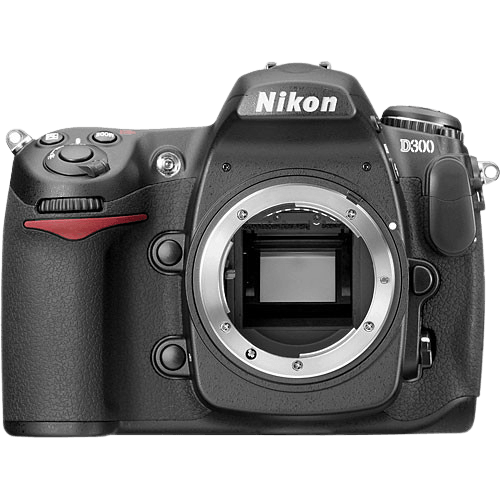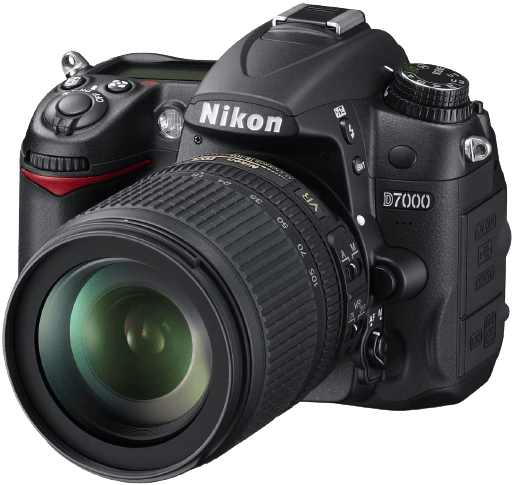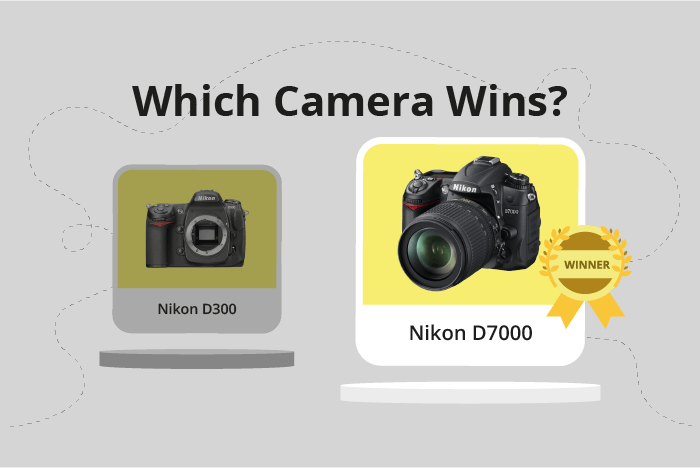Nikon D300 vs D7000 Comparison
Nikon D300

Nikon D7000

The Nikon D7000 wins against the Nikon D300 with a score of 56/100 compared to 49/100. Both cameras are DSLR types and share similarities in their specifications. They were released in 2010 and 2007, respectively.
The D7000 triumphs with its smaller size (132 x 105 x 77mm) and lighter weight (780g / 1.72lbs), making it more portable and easier to handle. The D300, however, has its advantages with its slightly larger size (147 x 114 x 74mm) which could provide better grip for some users, although it is heavier at 925g / 2.04lbs.
Ultimately, the Nikon D7000 is the better option due to its higher score, improved portability, and lower launch price. The Nikon D300 may still appeal to those who prefer a larger and heavier camera.
Nikon D300 vs D7000 Overview and Optics
The Nikon D7000 wins the optics comparison with a score of 55/100, while the Nikon D300 scores 47/100. Both cameras share several specifications, including a CMOS sensor type, APS-C sensor size, Nikon lens mounts, shooting speed of 6 frames per second, and no image stabilization. Despite these similarities, certain aspects set them apart, making one superior to the other in terms of optics.
The D7000’s superiority stems from its higher megapixel count of 16.2 compared to the D300’s 12.3, which allows for more detailed and sharper images. Additionally, the D7000 boasts an Expeed 2 processor, an upgrade from the D300’s Expeed processor, resulting in better image processing and quality. The D7000 also has a higher DXOMARK sensor score of 80, compared to the D300’s score of 67, indicating a better sensor performance in terms of dynamic range, color depth, and low-light capabilities.
On the other hand, the D300 has a few advantages, such as its Nikon F DX lens mount, which is specifically designed for APS-C sensor cameras, ensuring optimal compatibility with the camera body. This, however, does not outweigh the D7000’s overall better optics performance.
Given these factors, it is clear that the Nikon D7000 outperforms the Nikon D300 in terms of optics, offering superior image quality and sensor performance. While the D300 has a specific lens mount advantage, the D7000’s higher megapixel count, advanced processor, and better sensor score make it the better choice for those seeking enhanced optical performance.
Nikon D300 vs D7000 Video Performance
When examining the video capabilities of the Nikon D300 and the Nikon D7000, it is important to note that the Nikon D300 does not have any video functionality. This is a significant difference between the two cameras, as the Nikon D7000 has a video score of 57 out of 100.
The Nikon D7000 offers Full HD video with a maximum resolution of 1920 x 1080. This high-resolution video provides clear and detailed footage for a variety of uses. The camera also supports a maximum video frame rate of 24fps, which allows for smooth and natural motion in the recorded videos. Additionally, the Nikon D7000 features built-in time-lapse functionality, enabling users to create stunning time-lapse sequences without the need for additional equipment or software.
Taking into account the video capabilities of both cameras, the Nikon D7000 clearly stands out with its video functionality, while the Nikon D300 lacks this feature entirely. This difference may be a deciding factor for potential buyers, depending on their specific needs and preferences in a camera.
Nikon D300 vs D7000 Features and Benefits
The Nikon D7000 wins the features comparison with a score of 57/100, while the Nikon D300 scores 54/100. Both cameras share several specifications, including a 3-inch screen size, lack of touchscreen, flip screen, GPS, and Bluetooth. However, there are differences that contribute to the D7000’s higher score and advantages over the D300.
The D7000 has a slight edge in screen resolution with 921,000 dots compared to the D300’s 922,000 dots. This difference in resolution provides a marginally clearer view when reviewing images on the camera’s screen. The most significant advantage the D7000 has over the D300 is the inclusion of WIFI connectivity, allowing for easy transfer of images to other devices and remote control of the camera via a smartphone app.
On the other hand, the D300 does not offer any notable advantages over the D7000 in terms of features. Both cameras possess the same screen size, lack of touchscreen, flip screen, GPS, and Bluetooth. The only difference is the slightly lower screen resolution, which does not significantly impact overall performance or usability.
Given these comparisons, the Nikon D7000 emerges as the better camera in terms of features, mainly due to its WIFI connectivity and marginally higher screen resolution. The Nikon D300, while still a capable camera, falls short in providing any additional benefits over the D7000. Therefore, for those prioritizing features in their camera choice, the Nikon D7000 is the more appealing option.
Nikon D300 vs D7000 Storage and Battery
The Nikon D7000 wins in storage and battery with a score of 79, compared to the Nikon D300’s score of 43. The D7000 has dual memory card slots and accepts SD, SDHC, and SDXC cards. The D300 only accepts Compact Flash (Type I or II). Additionally, both cameras lack USB charging capabilities.
The D7000 has a slightly longer battery life of 1050 shots, using the EN-EL15 battery type. This advantage allows users to capture more images before needing to recharge or replace the battery. On the other hand, the D300 has a battery life of 1000 shots, utilizing the EN-EL3e battery type. Although the difference in battery life is minimal, the D7000 still comes out ahead in this aspect.
Despite the D7000’s advantages in storage compatibility and battery life, the D300 remains a reliable option for photographers who prefer Compact Flash cards. The 50-shot difference in battery life may not be significant enough to sway users towards the D7000 if they value other features of the D300 more.
Nikon D300 vs D7000 – Our Verdict
Are you still undecided about which camera is right for you? Have a look at these popular comparisons that feature the Nikon D300 or the Nikon D7000:

